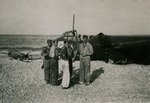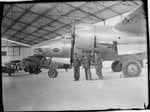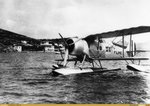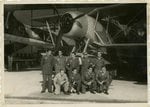During World War II, Spain interned several aircrafts, both Allied and Axis, and in some rare cases, the spanish goverment negotiated the purchase of some of them. The aircraft landed and were incorporated into the Air Force were:
Junkers Ju 88 bombers 18 different variations of 21 who came to Spain (variants: A-4, A-4 Trop, A-14, C-6, D-1 and D-1 Trop).
5 naval reconnaissance seaplanes Romeo Ro-43.
3 maritime patrol aircraft Focke-Wulf Fw 200C Condor (one almost joined Iberia, only one came flying in the Air Force).
Junkers Ju 290 1 Transport A-5 of Lufthansa (joined the Air Force).
1 North American bomber B-25 Mitchell (incorporated into the Air Force).
1 patrol aircraft Consolidated PBY-5A Catalina, bought by Spain.
Fairey Swordfish 1 seaplane (built to the Air Force).
3 transport aircraft Douglas C-47 (incorporated into Iberia).
1 Potez 63-11 (rated by the Air Force).
During the Second World War there were numerous incidents in which the Spanish airspace was violated. Some of the incidents consisted of accidents, such as V9115 Hudson 24 Squadron RAF crashed in front of La Coruna in December 1941. Other planes came as a result of fighting, as the Consolidated PB4Y-1 Liberator of VB-103 (serial number 32 022) attacked by six Ju-88 near Cape Finisterre, on September 4, 1943 and had to ditch in front of the coast. During World War II, were also detained two German submarines, the U-760 and U-573, 9 the latter was incorporated into the Spanish Navy initially with the numeral G7, the first of these was delivered to the UK a After the contest.
Junkers Ju 88 bombers 18 different variations of 21 who came to Spain (variants: A-4, A-4 Trop, A-14, C-6, D-1 and D-1 Trop).
5 naval reconnaissance seaplanes Romeo Ro-43.
3 maritime patrol aircraft Focke-Wulf Fw 200C Condor (one almost joined Iberia, only one came flying in the Air Force).
Junkers Ju 290 1 Transport A-5 of Lufthansa (joined the Air Force).
1 North American bomber B-25 Mitchell (incorporated into the Air Force).
1 patrol aircraft Consolidated PBY-5A Catalina, bought by Spain.
Fairey Swordfish 1 seaplane (built to the Air Force).
3 transport aircraft Douglas C-47 (incorporated into Iberia).
1 Potez 63-11 (rated by the Air Force).
During the Second World War there were numerous incidents in which the Spanish airspace was violated. Some of the incidents consisted of accidents, such as V9115 Hudson 24 Squadron RAF crashed in front of La Coruna in December 1941. Other planes came as a result of fighting, as the Consolidated PB4Y-1 Liberator of VB-103 (serial number 32 022) attacked by six Ju-88 near Cape Finisterre, on September 4, 1943 and had to ditch in front of the coast. During World War II, were also detained two German submarines, the U-760 and U-573, 9 the latter was incorporated into the Spanish Navy initially with the numeral G7, the first of these was delivered to the UK a After the contest.

































